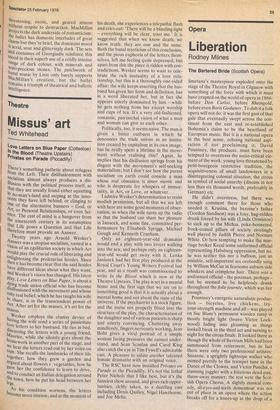Arts
Romanticism's dark underside
Bryan Robertson
Mayerling (Covent Garden)
I can't convey my huge and astonished admiration for Kenneth MacMillan's new three-act ballet, without a preliminary detour around areas of semiautobiography, or self-explanation, against which my training as a critic puts up endless barriers because of the obvious dangers of flabby self-indulgence. My excuse here is the possibility that personal prejudices aired for a minute or two may strike a responsive chord among readers who want to know whether or not to buy an expensive ticket for a long evening at Covent Garden. For Mayerling, the short answer is yes, but now for the quick detour.
Being largely self-educated has peculiar pleasures and advantages in the way that you instinctively search out and devour books or some aspect or another of culture at times in your life when you need, imaginatively and factually, that particular experience as opposed to having it drilled into you when its only relevance, maybe, is to an academic curriculum. Shakespeare at fifteen can wash over you in waves of boredom, ten years later you're riveted. But this kind of wayward progress can trap you into ludicrous prejudices. I couldn't read Trollope for years because C. P. Snow's wooden novels bored me to death and his admiration for Trollope practically triggered off a national revival of enthusiasm for those splendid Victorian chronicles.
But in the theatre, which obviously includes ballet, we're all self-educated and there's a licence for prejudice because of the essential character and purposes of entertainment, whatever the aesthetic or intellectual level may be. But in my case, a lack of sympathy for modern narrative ballet the dance-drama that tells a story within the clearly defined and understood boundary of mime and symbolic gesture has persisted because of my professional involvement in the presentation and critical interpretation of modern painting and sculpture. And here, the main creative thrust in my lifetime has revolved around abstraction.
In abstract art there's been some real invention that includes emotional elo quence, as well as decoration, and not just the establishment of new formal principles. Figurative or directly representational art has been largely undermined or robbed of purpose through the existence of photography and cinema which can both record and invent The best figurative art has also been distinctly gloomy in tone because it's hard to portray reality in cheerful innocence in a post-Freudian world. Given that abs
tract art has its own sterile academy and vacuities, most figurative art that's tried to
ignore that lost innocence has exploited tradition without extending it, relating the present only to the past inside its own, more recognisable, academy.
With dance, it has taken Kenneth MacMillan's brilliant imagination as a choreog
rapher to dissolve my distrust of narrative ballet, most particularly when it deals with historical themes, springing from fact ut fantasy, dressed and decorated in period
costumes and sets. The whole enterprise can so easily be a lifeless exercise in period taste, the theatrical Grand Machine equi'
valent of bad academic painting. But if Bacon, or even lighter weight Hockney, can revitalise and so extend the tradition of figurative art through their instinctivelY post-Freudian awareness, so can MacMillan, in ballet, with his powerful insights into character and situation.
MacMillan has shown great courage hi setting so many of his most ambitious works in history, from the Edwardian context ot The Invitation, back to Romeo and Juliet and then on again to the more recent his' torical periods of Manon, Anastasia and now Mayerling. Courageous in my eyes, at any rate, because the bare plots and place' mcnt in time of these ballets could suggest nothing more, in essence, than melodramatic and visually spectacular refurb• ishings of, say, Giselle, propped up by new sociological and historical contexts.
MacMillan's more purely abstract ballets, which includes a masterwork, The Song of the Earth, synthesize underpinning of min' imal dramatic structure with more obvious abstract invention in dance terms for its own sake and this invention has never flagged his last work in this genre, the Japanese' inspired Rituals, in fact breaks new ground in its exotic austerity and force. Most of MacMillan's ballets, descriptive or abstract, tackle themes of crisis and violence and the dramatic momentum of Mayerling springs from a chilly dissection of both these elements.
The steely, clear-cut unfolding of the plot is due partly to Gillian Freeman's tight, unsentimental scenario: the double suicide of Crown Prince Rudolf of AustriaHungary and the seventeen-year-old Baroness Vetsera, their coldly passionate love affair, the unhappy political marriage of the Crown Prince, the oppressive court life with its hollow elegance and formality the fast-moving scenario is exactly matched bY the ferocious pace and energy of MacMillan's choreography. The action revolves around the startling progression of duets for the two principal dancers: abrasive, threatening, erotic, and geared almost Without respite to destruction. MacMillan Projects the dark underside of romanticism: the ballet has domestic interludes of great Charm but they're brief, the dominant mood IS acrid, sour and glitteringly dark. The sets and costumes of Georgiadis reinforce this mood in their superb use of a coldly intense range of dark colour, with minerals and semi-precious stones. The patchwork of banal music by Liszt only barely supports MacMillan's creation, but the ballet remains a triumph of theatrical and balletic intelligence.



































 Previous page
Previous page